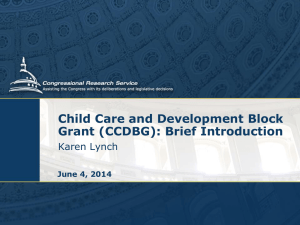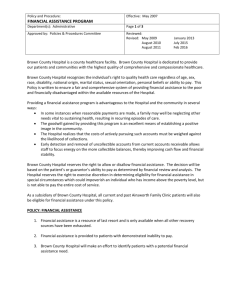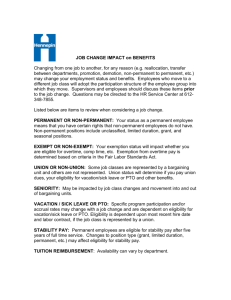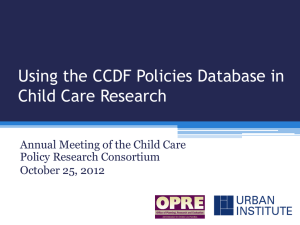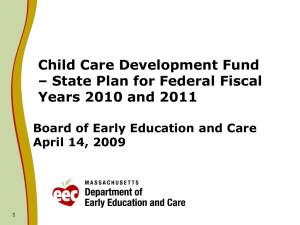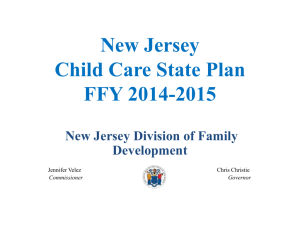ehs-cc partnership topical session: ccdbg/ccdf
advertisement
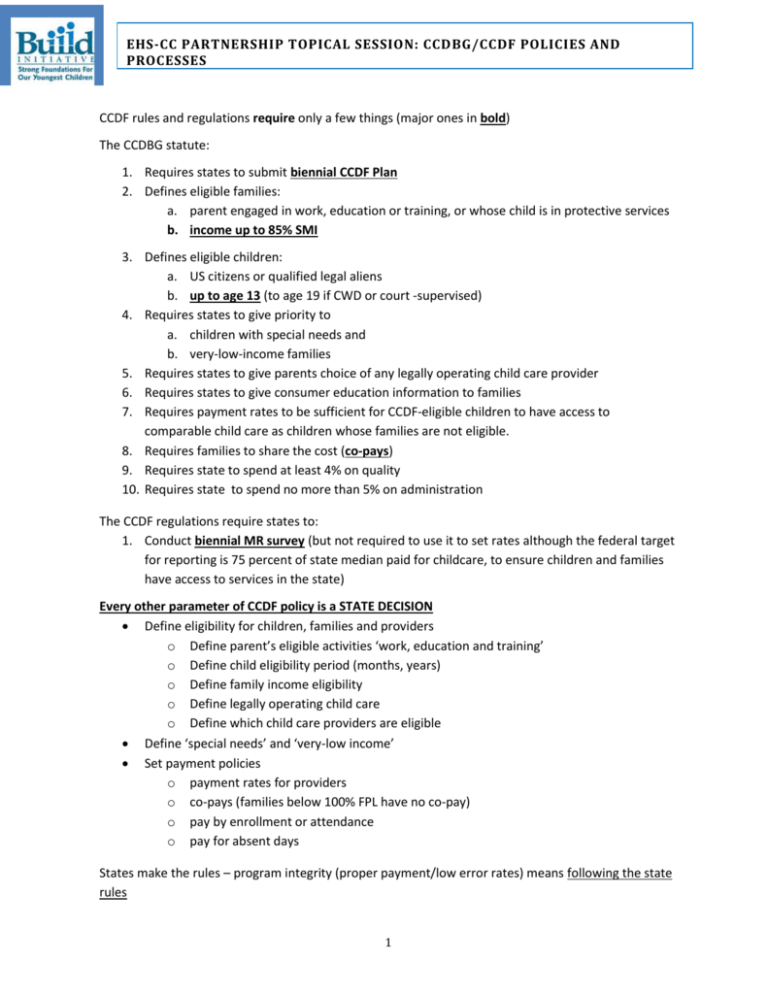
EHS-CC PARTNERSHIP TOPICAL SESSION: CCDBG/CCDF POLICIES AND PROCESSES CCDF rules and regulations require only a few things (major ones in bold) The CCDBG statute: 1. Requires states to submit biennial CCDF Plan 2. Defines eligible families: a. parent engaged in work, education or training, or whose child is in protective services b. income up to 85% SMI 3. Defines eligible children: a. US citizens or qualified legal aliens b. up to age 13 (to age 19 if CWD or court -supervised) 4. Requires states to give priority to a. children with special needs and b. very-low-income families 5. Requires states to give parents choice of any legally operating child care provider 6. Requires states to give consumer education information to families 7. Requires payment rates to be sufficient for CCDF-eligible children to have access to comparable child care as children whose families are not eligible. 8. Requires families to share the cost (co-pays) 9. Requires state to spend at least 4% on quality 10. Requires state to spend no more than 5% on administration The CCDF regulations require states to: 1. Conduct biennial MR survey (but not required to use it to set rates although the federal target for reporting is 75 percent of state median paid for childcare, to ensure children and families have access to services in the state) Every other parameter of CCDF policy is a STATE DECISION Define eligibility for children, families and providers o Define parent’s eligible activities ‘work, education and training’ o Define child eligibility period (months, years) o Define family income eligibility o Define legally operating child care o Define which child care providers are eligible Define ‘special needs’ and ‘very-low income’ Set payment policies o payment rates for providers o co-pays (families below 100% FPL have no co-pay) o pay by enrollment or attendance o pay for absent days States make the rules – program integrity (proper payment/low error rates) means following the state rules 1 EHS-CC PARTNERSHIP TOPICAL SESSION: CCDBG/CCDF POLICIES AND PROCESSES CCDBG POLICIES FOR MODIFICATION ELIGIBILITY: Annual redetermination – children are found eligible for 1 year of service and are not required to prove eligibility more than annually in most circumstances (supported by CCDF proposed changes) And Limited or no look back related to income or household changes - families do not need to report or pay back money if income or household changes happen in the eligible year and do not impact the income by x percent Presumptive eligibility – children and families who bring some level of documentation are presumed eligible and link to childcare programs while given time to produce additional documentation as required (e.g. birth certificate, additional paycheck stubs) Immediate access across services models – children who are eligible for one service Part C, Home visiting, childcare or Head Start can have immediate access to the other state or federally funded types of care, if eligible. States should seek to create aligned eligibility requirements. Sibling eligibility – to support families’ once one sibling is found eligible for services other children are eligible and can gain access to care without the waitlist Define “eligible activity” broadly (e.g., include job search) and with no minimum hours. Match child’s hours to hours parent needs plus always allow child to attend during the school day hours (so able to benefit from the program regardless of whether those hours match parent activity hours) Define CCDF “priority categories” to match Head Start’s automatically eligible ones: protective service, homeless, TANF recipient, [and teen parent?] Continuity (covers breaks in services) – children can remain in services for up to 1 year, regardless of change in eligibility (this is what HS does) which may include breaks as defined by the state (e.g. seasonal employment, job lost and job search) PAYMENT POLICY Establish the payment unit as 1 month Payment unit: Twenty-three (23) States and Territories use weekly and 16 use monthly units of payment for some or all providers and families. The rate structures of 19 States and Territories include hourly units and 28 States and Territories have some daily rates in their structures. Only 3 States (KS, MI and SD) pay exclusively on an hourly basis. 2 EHS-CC PARTNERSHIP TOPICAL SESSION: CCDBG/CCDF POLICIES AND PROCESSES Pay based on enrollment with an Attendance Benchmark (85% same as Head Start) Enrollment -based payment policy: Six (6) States (CT, ID, ME, NM, PA, and UT) base payment on enrollment without payment reductions for absences during the payment period. Attendance-based payment policy: Thirty-seven (37) States and Territories base their payment on attendance. Absence policy: Of the 37 States and Territories that base payment on attendance, 30 pay for absences within stated thresholds and under special circumstances, such as illness or disability. Seven (7) States (CO, MI, NE, TX, VT, WA, and WV) do not pay for absences. Contracts vs. Vouchers contracts are used to establish a level of financial commitment to programs based on the number of children they will serve throughout the year. Contracts can also establish other requirements such as training, ratios, – don’t need contracts to require these unless state does not have QRIS participation and accreditation. Can require QRIS participation for any subsidy use (contracts supported in part by CCDF proposed regulatory changes) Reduced or limited co payments – decisions must be made on a case by case but could include parents who choose higher quality settings, teen parents, homeless families, families from child protective services, families in job search, at or below specific income levels – Note: can waive co-pays for TANF, all families with income <100% FPL and all protective services. Cannot waive co-pays for families >100%FPL but state can reduce the co-pay to $1/month Definition of full time vs. part-time care – create a uniform definition of part time and full time services (two days, three days or full time) Schedule of Care – allow families to determine the hours of care based on child and parent need vs. specific hours of work, create more uniform access for children Ratios – align with Head Start ratios for staff to children served in a classroom Health and Safety requirements – align with proposed federal CCDF regulation changes Proposed rules: Comprehensive criminal background checks (including fingerprints) Compliance with applicable state and local fire, health and building codes, before determined before serving children with subsidies Emergency preparedness and response planning Strengthening Monitoring including unannounced visits with minimum standards, states will not be able to rely on self-certification Pre-Service and In-service Training requirements – align with proposed federal CCDF regulation changes -- Minimum pre-service and orientation training (first aid, CPR, SIDS prevention, nutrition, etc.) 3



